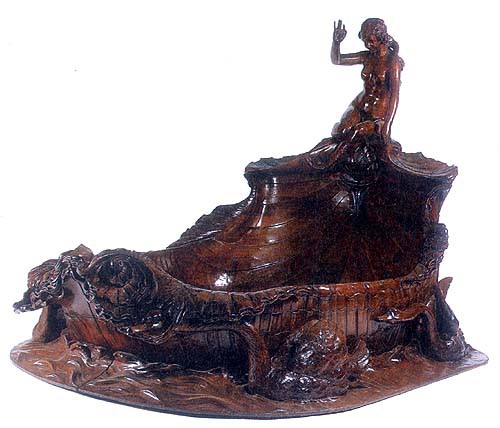This bed, recently put up for auction in Paris, embodies the life of the French courtisane in the second half of the 19th century. On 30 October, 1946, the expert Maurice Rheims had decribed the bed, which formed part of the furniture for a town mansion, as “designed for a very particular use”: the Marthe Richard law passed earlier that year (13 April) had outlawed brothels and caused them to shut up shop. This infamous bed was in 6, rue des Moulins near to the Palais Royal, a house which, in its time, had welcomed Toulouse Lautrec, not only as customer but also as painter. And as a willing resident Lautrec painted a famous series of works there in 1894. Biographies of the painter are not lacking in rich description of the luxurious house in rue des Moulins, underlining the extravagance of the furniture, with its vermeil bath and la Païva bed. How did these items get there? No one knows.
It is not known who commissioned the bed, nor is there any proof that it was ever delivered to one of la Païva's residences. And yet, everything seems to point in la Païva's direction. The mahogany bed is in fact a piece of sculpture, a conch floating on the sea, topped with a full relief mermaid and drawn by swans. This perfect stage set lacks only the Venus rising from the waves, the principal nude theme during the Second Empire. In this case, the venus was called the Marquise de la Païva, great courtisane born into poverty in 1819 in the Jewish ghetto in Moscow. La Païva used her beauty to devour fortune after fortune, thus becoming one of the scandalous queens of charm during the Second Empire. She was naturally one of the sources of inspiration for Zola's Nana. However, it was La Païva's town mansion which was the model for that in Zola's Les Rougon-Macquart. Of all the call girls of the period, la Païva was the most flashily ostentatious, notably in her town mansion built between 1856 and 1866 at 25, Avenue des Champs-Élysées. The (still existing) mansion was designed in the neo-renaissance style by the architect Pierre Manguin, and it was given to La Païva by the Comte Henckel de Donnersmarck, a cousin of Bismarck's, whom she married in 1871. The house itself was frequented by greats such as Théophile Gautier, Arsène Houssaye, Sainte-Beuve and the Goncourt brother, and it was famed for its ostentatious decoration, produced by some of the best artists of the period, notably the painter Baudry, the sculptors Barrias, Carrier-Belleuse and Dalou, the bronze smith Barbedienne, and the cabinet makers Kneib and Fourdinois. And some of the details in La Païva's house caused much scandal, notably the silver bath with three taps – the last being for champagne ! – and the monumental onyx staircase, about which the gossips used to say, paraphrasing a line from Phèdre: “Ainsi que la vertu, le vice a ses degrés”. ('Just like virtue, vice too has its steps or stages'.
Karine Huguenaud (tr. P.H.)
*Vente Artcurial, Hôtel Marcel-Dassault, 19 December, 2006. Estimate 500,000/800,000 € (unsold).
January 2007
The so-called "la Païva" bed
Artist(s) : Anonymous

- Date :
- second half of the 19th century
- Technique :
- mahogany
- Dimensions :
- H = 2.10 m, L = 3.02 m, P = 2.22 m
- Photo credit :
- © Artcurial

